2015中考英语专题突破课标版专题精讲五 连 词
文档属性
| 名称 | 2015中考英语专题突破课标版专题精讲五 连 词 | 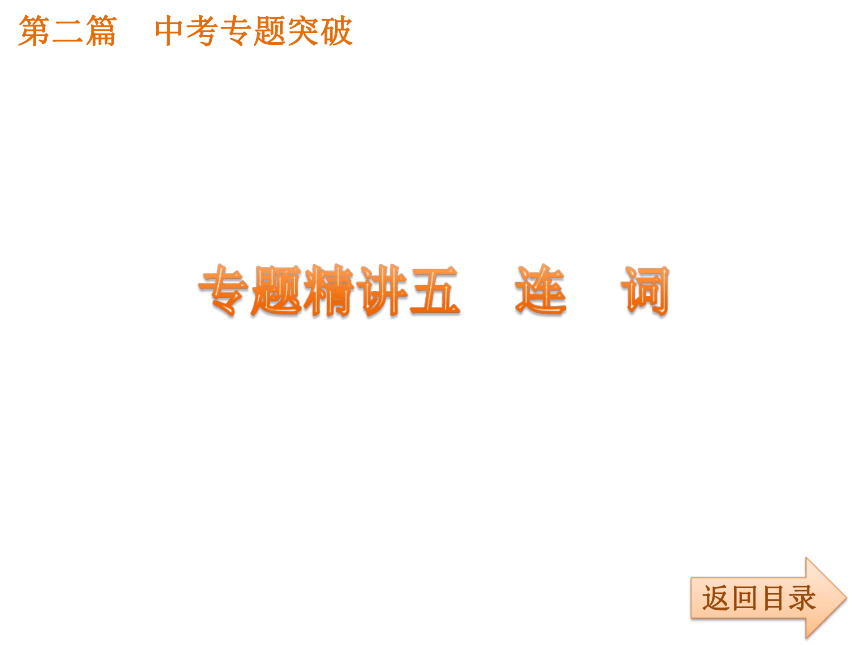 | |
| 格式 | zip | ||
| 文件大小 | 2.2MB | ||
| 资源类型 | 教案 | ||
| 版本资源 | 通用版 | ||
| 科目 | 英语 | ||
| 更新时间 | 2015-04-28 21:43:07 | ||
图片预览

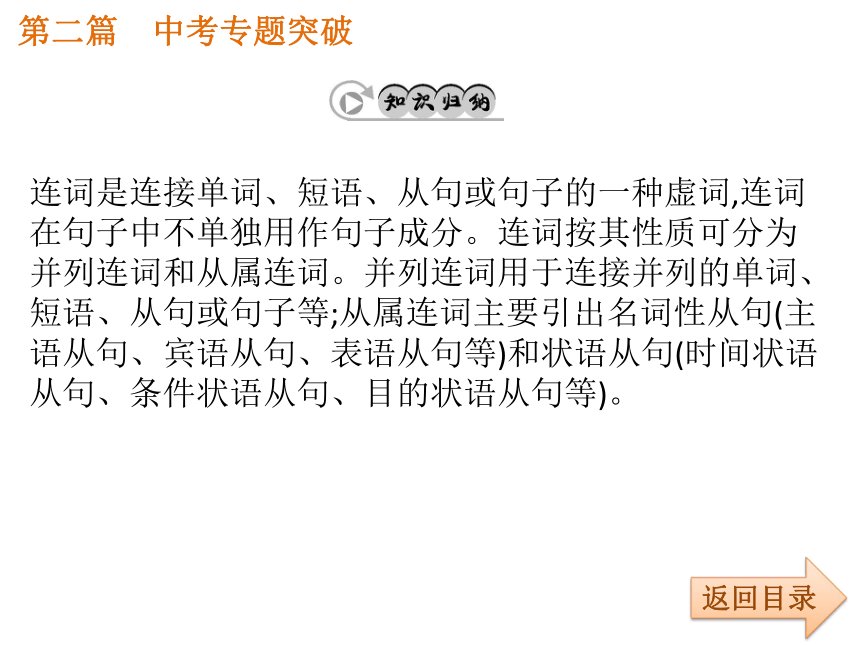
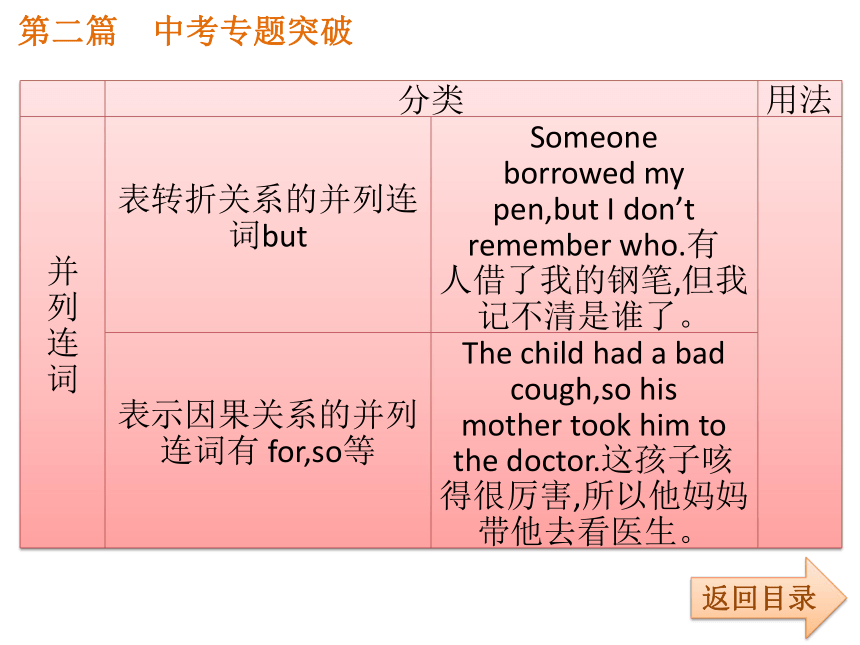
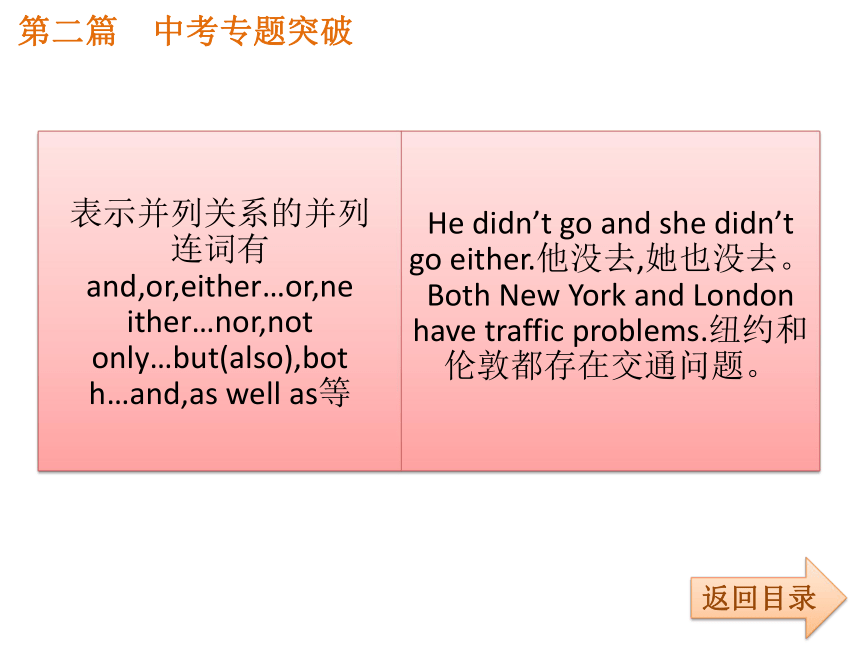
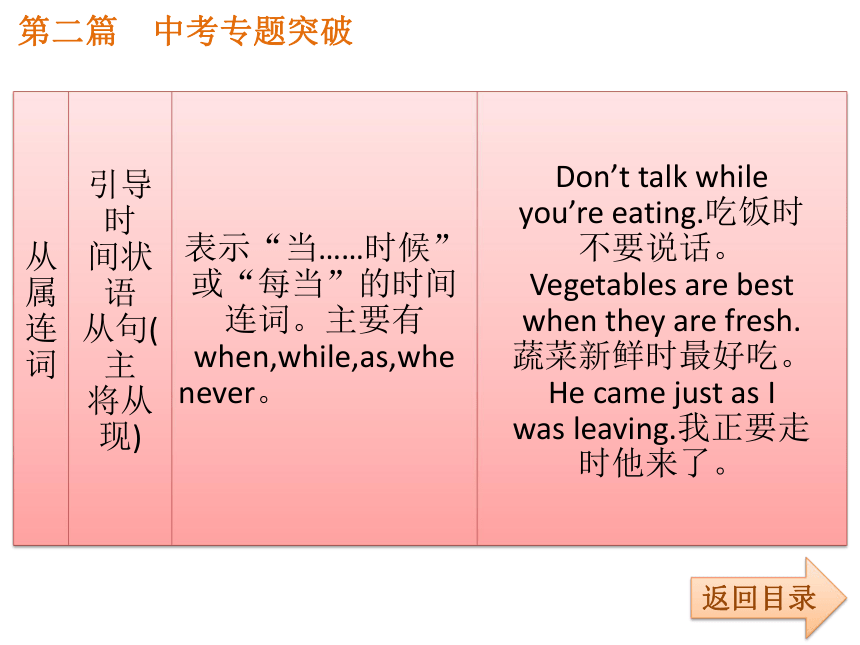
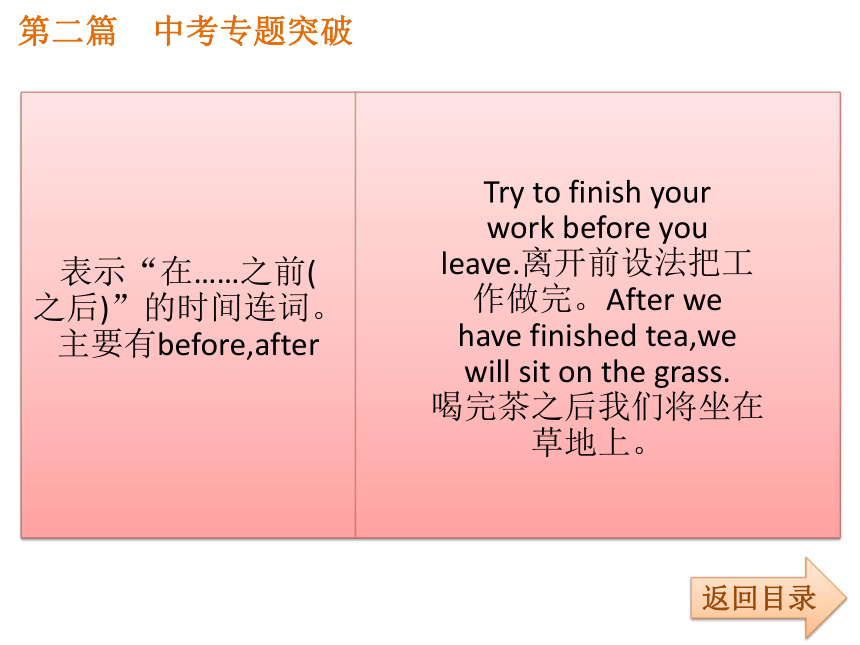
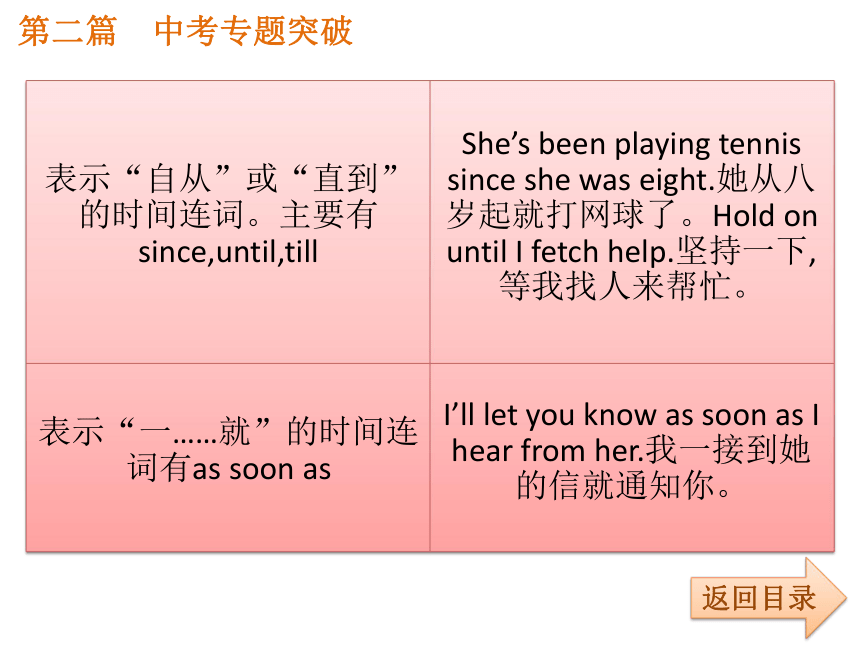
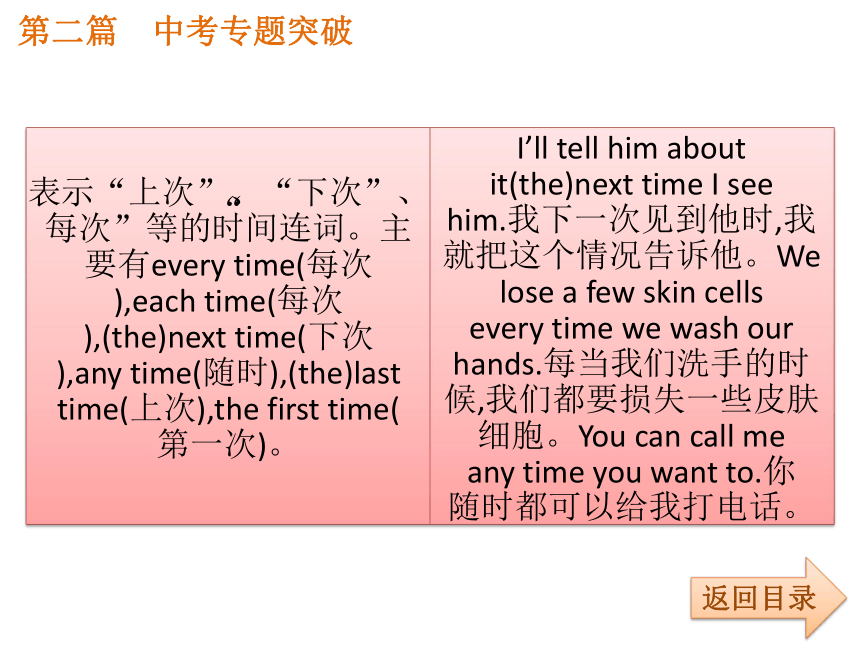
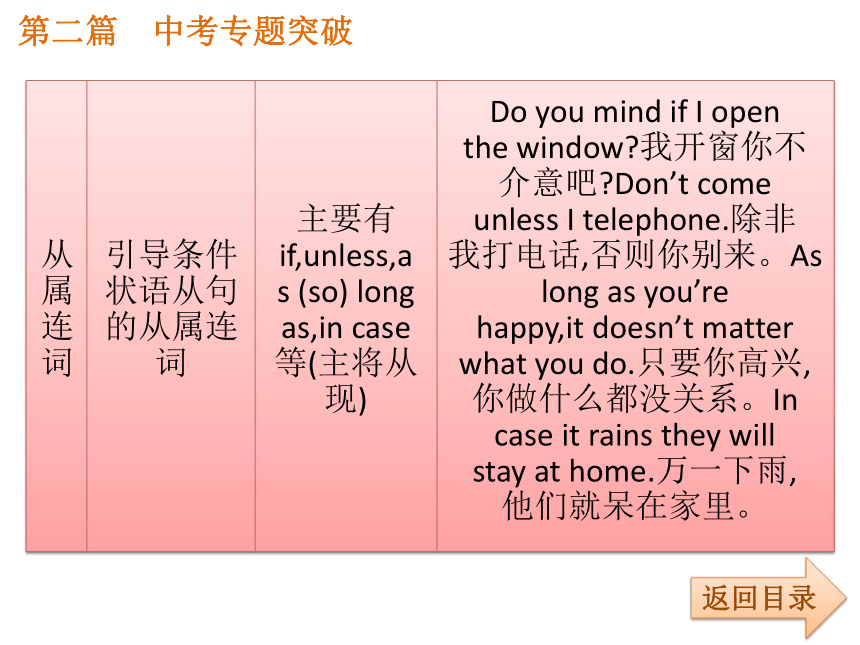
文档简介
课件24张PPT。第二篇 中考专题突破返回目录专题精讲五 连 词第二篇 中考专题突破返回目录连词是连接单词、短语、从句或句子的一种虚词,连词在句子中不单独用作句子成分。连词按其性质可分为并列连词和从属连词。并列连词用于连接并列的单词、短语、从句或句子等;从属连词主要引出名词性从句(主语从句、宾语从句、表语从句等)和状语从句(时间状语从句、条件状语从句、目的状语从句等)。第二篇 中考专题突破返回目录第二篇 中考专题突破返回目录第二篇 中考专题突破返回目录第二篇 中考专题突破返回目录第二篇 中考专题突破返回目录第二篇 中考专题突破返回目录第二篇 中考专题突破返回目录第二篇 中考专题突破返回目录第二篇 中考专题突破返回目录第二篇 中考专题突破返回目录第二篇 中考专题突破返回目录第二篇 中考专题突破返回目录第二篇 中考专题突破返回目录第二篇 中考专题突破返回目录第二篇 中考专题突破返回目录1.and与or辨析
(1)and 表示“和、且”,一般用在肯定句中连接并列的成分。在句型“祈使句+and ……”中,“and” 表示“那么”之意。相当于“If……”。如:Study hard,and you will succeed.=If you study hard,you will succeed.
(2)or 有“或”的意思,表示一种选择。如:Would you like tea or water?
(3)在句型“祈使句…,or…”中,or 表示否则相当于“If …not …”如:Study hard,or you will fail.=If you don’t study hard,you will fail.第二篇 中考专题突破返回目录(4)列举成分是主语,在否定词之前,用and 连接;而在否定词之后的列举成分用or 连接构成完全否定。如:Lucy and Lily cannot speak French.They didn’t speak Germany clearly or correctly,either.Lucy和Lily 不会说法语,德语也说得不清楚,不正确。
(5)在否定句中,如果所连接的两个部分都有否定词,则用and 连接而不用or。如:The clock has no eyes and no ears.And it has no mouth and it has no legs,either.钟表没有眼睛和耳朵,也没有嘴和腿。第二篇 中考专题突破返回目录(6)在否定句中,without之后若有列举成分用and 连接构成完全否定;而在肯定句中,without之后的列举成分要用or 连接才能构成完全否定。如:Man can’t live without air and water.That’s to say,man will die without air or water.没有空气和水,人就不能生存,也就是说,没有空气和水,人就会死。第二篇 中考专题突破返回目录2.both意为“两者都”,由both构成的短语both of…;both…and…连接的并列成分做主语时,谓语动词用复数。如:Both the answers are right.Both of us are students.Both you and she are right.
3.either意为“两者当中任何一个”,后有of 时接名词的复数形式,无of时接单数名词,动词用单数形式。如“You may wear either of the hats.短语“either …or…”意为 “不是……就是……;或者……或者……”,连接的并列成分做主语时,动词与临近的主语保持一致。即“就近原则”。如:Either you or he has to go =Either he or you have to go.第二篇 中考专题突破4.neither意为“两者当中都不”,后有of时接名词的复数形式,无of时接单数名词,并且谓语动词只用单数形式。如:Neither of the answers is right.短语“neither…nor…”意为“既不……也不……”,该短语连接并列主语时,谓语动词与临近的主语保持一致。即“就近原则”。如:Neither you nor I am right.=Neither I nor you are right.
5.在条件状语从句中,通常要用一般现在时表示将来意义,而不能直接使用将来时态。不过,有时表示条件的 if之后可能用 will,但那不是将来时态,而是表示意愿或委婉的请求(will为情态动词)。如:If you will sit down for a few moments,I’ll tell the manager you’re here.请稍坐,我这就告诉经理说你到了。返回目录第二篇 中考专题突破返回目录6.不能同时出现在一个句子中的连词。
(1)because,so 不能同时出现在一个句子里,只用其中之一。如:We knew him in our school,so we had no trouble in finding him.
(2)though/although与but不能同时出现在一个句子里,只用其中之一。但though 可以与yet,still 同时出现在一个句子中。如:Though Australia is very large,the population is quite small.第二篇 中考专题突破返回目录7.必须用whether 的情况。
(1)discuss和介词后的宾语从句用whether。如:We are discussing whether we’ll hold a meeting.I’m worried about whether she can come to the meeting.
(2)和不定式、or not 连用必须用whether。如:I don’t know whether to leave or not.第二篇 中考专题突破返回目录8.引导宾语从句的连词。
(1)that 连接由陈述句转变而来的宾语从句。
(2)who,whom,what,which,whose,when,where,why,how连接由特殊疑问句转变而来的宾语从句。
(3)if/whether 连接由一般疑问句转变而来的宾语从句。
(1)and 表示“和、且”,一般用在肯定句中连接并列的成分。在句型“祈使句+and ……”中,“and” 表示“那么”之意。相当于“If……”。如:Study hard,and you will succeed.=If you study hard,you will succeed.
(2)or 有“或”的意思,表示一种选择。如:Would you like tea or water?
(3)在句型“祈使句…,or…”中,or 表示否则相当于“If …not …”如:Study hard,or you will fail.=If you don’t study hard,you will fail.第二篇 中考专题突破返回目录(4)列举成分是主语,在否定词之前,用and 连接;而在否定词之后的列举成分用or 连接构成完全否定。如:Lucy and Lily cannot speak French.They didn’t speak Germany clearly or correctly,either.Lucy和Lily 不会说法语,德语也说得不清楚,不正确。
(5)在否定句中,如果所连接的两个部分都有否定词,则用and 连接而不用or。如:The clock has no eyes and no ears.And it has no mouth and it has no legs,either.钟表没有眼睛和耳朵,也没有嘴和腿。第二篇 中考专题突破返回目录(6)在否定句中,without之后若有列举成分用and 连接构成完全否定;而在肯定句中,without之后的列举成分要用or 连接才能构成完全否定。如:Man can’t live without air and water.That’s to say,man will die without air or water.没有空气和水,人就不能生存,也就是说,没有空气和水,人就会死。第二篇 中考专题突破返回目录2.both意为“两者都”,由both构成的短语both of…;both…and…连接的并列成分做主语时,谓语动词用复数。如:Both the answers are right.Both of us are students.Both you and she are right.
3.either意为“两者当中任何一个”,后有of 时接名词的复数形式,无of时接单数名词,动词用单数形式。如“You may wear either of the hats.短语“either …or…”意为 “不是……就是……;或者……或者……”,连接的并列成分做主语时,动词与临近的主语保持一致。即“就近原则”。如:Either you or he has to go =Either he or you have to go.第二篇 中考专题突破4.neither意为“两者当中都不”,后有of时接名词的复数形式,无of时接单数名词,并且谓语动词只用单数形式。如:Neither of the answers is right.短语“neither…nor…”意为“既不……也不……”,该短语连接并列主语时,谓语动词与临近的主语保持一致。即“就近原则”。如:Neither you nor I am right.=Neither I nor you are right.
5.在条件状语从句中,通常要用一般现在时表示将来意义,而不能直接使用将来时态。不过,有时表示条件的 if之后可能用 will,但那不是将来时态,而是表示意愿或委婉的请求(will为情态动词)。如:If you will sit down for a few moments,I’ll tell the manager you’re here.请稍坐,我这就告诉经理说你到了。返回目录第二篇 中考专题突破返回目录6.不能同时出现在一个句子中的连词。
(1)because,so 不能同时出现在一个句子里,只用其中之一。如:We knew him in our school,so we had no trouble in finding him.
(2)though/although与but不能同时出现在一个句子里,只用其中之一。但though 可以与yet,still 同时出现在一个句子中。如:Though Australia is very large,the population is quite small.第二篇 中考专题突破返回目录7.必须用whether 的情况。
(1)discuss和介词后的宾语从句用whether。如:We are discussing whether we’ll hold a meeting.I’m worried about whether she can come to the meeting.
(2)和不定式、or not 连用必须用whether。如:I don’t know whether to leave or not.第二篇 中考专题突破返回目录8.引导宾语从句的连词。
(1)that 连接由陈述句转变而来的宾语从句。
(2)who,whom,what,which,whose,when,where,why,how连接由特殊疑问句转变而来的宾语从句。
(3)if/whether 连接由一般疑问句转变而来的宾语从句。
同课章节目录
- 词法
- 名词
- 动词和动词短语
- 动词语态
- 动词时态
- 助动词和情态动词
- 非谓语动词
- 冠词
- 代词
- 数词和量词
- 形容词副词及其比较等级
- 介词和介词短语
- 连词和感叹词
- 构词法
- 相似、相近词比较
- 句法
- 陈述句
- 一般疑问句和否定疑问句
- 特殊疑问句及选择疑问句
- 反意疑问句
- 存在句(There be句型)
- 宾语从句
- 定语从句
- 状语从句
- 主谓一致问题
- 简单句
- 并列句
- 复合句
- 主谓一致
- 主、表语从句
- 名词性从句
- 直接引语和间接引语
- 虚拟语气
- 感叹句
- 强调句
- 倒装句
- 祈使句
- 句子的成分
- 句子的分类
- 题型专区
- 单项选择部分
- 易错题
- 完形填空
- 阅读理解
- 词汇练习
- 听说训练
- 句型转换
- 补全对话
- 短文改错
- 翻译
- 书面表达
- 任务型阅读
- 语法填空
- 其他资料
